[~ 10 minutes]
Listening to: Litchmond, Chasing rainbows
{Second instalment of a series of articles on Ugandan bananas, part of the Ugandan portraits series. For the first article, see here; for an introduction to the project, see here (it opens in new tab).}
I forgot to say it before, but matoke isn’t African, either. Adopted and made honorary African crop, yes. But not originally so.
So, where does it come from?
The homeland of the banana, the species out of which all our edible bananas come from, is in Southern Asia & Papua New Guinea (PNG). Quite far away from Lake Victoria, as you can see.
These species are two: Musa acuminata Colla., and Musa balbisiana Colla. The first is found mostly in PNG and surrounding islands; the second, in mainland Southeast Asia. These two species are genetically distinct, and are referred to, in the literature, as possessing an AA genome (M. acuminata), or a BB genome (M. balbisiana).
For those who know little to no genetics, I’ll clear up that most higher living organisms have two sets of chromosomes (basically, each chromosome is a long, very tightly packed strand of DNA); each set is referred to by a letter (A, or B, in this case). Each set contains information about the same characters, but the information needn’t be (and most often is not) the same.
That is, a certain gene bundled up in a certain position in the chromosome might contain information about how sweet the fruit will be, but the actual ‘instruction’ the gene is giving (eg. “very sweet”, or “set-your-teeth-on-edge-tart”) might be different depending on the set of chromosomes we’re talking about. You usually inherit one set from your mother, and another one from your father.
Unless you’re a plant, eg. a banana; then things can get really interesting…
I wouldn’t even be mentioning this, if it weren’t for the banana’s absurdly chaotic genetic mess. Being passingly acquainted with wheats, I shouldn’t be surprised at how complicated plant crop genetics can get. But the case with bananas is slightly different.
Turns out that, during the cultivation and breeding history of bananas, both genomes have contributed to different kinds of bananas. The seedless ones we know and eat are usually triploid (ie. they have three sets of chromosomes): AAA, AAB, or ABB.
(Okay, technically there are BBBs, too, and some funky bananas (Fe’i) that aren’t descended from these two parents, and… it’s complicated. Let’s leave it here, and for those interested in the banana’s genetic rollercoaster of fun, scroll down and click away into the jungle…)
The story of banana domestication in southern east Asia (Indonesian islands included) is fascinating; it involves subspecies so finely differentiated at the genetic level, that they seldom give fertile offspring when hybridized; island-hopping atop canoes with Oceanic prehistoric dwellers; diploid kids, then triploid ones; a back-and-forth movement of genes, language terms, crops.

However, I was utterly befuddled when I realized that bananas had reached Africa a long time ago. Long enough that their presence has been presumed by some to enable (dare I say even fuel?) the Bantu expansion of farmer tribes in tropical West Africa, some 3000-4000 years ago (c. 1000-2000 BC). These tribes, originally from around eastern Nigeria and western Cameroon, practically overran most of subequatorial Africa, replacing (or absorbing via marriage) most of the original inhabitants, or so the story goes.
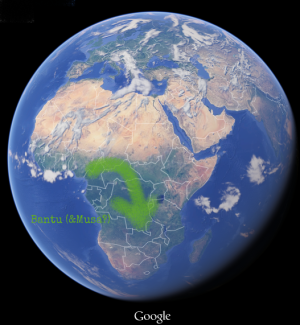
Funny thing is, the Bantu expansion began in west Africa. And bananas were there more than 3000 years ago, ready to feed the expanding populations that conquered and farmed the rainforest (a key feature upon which the whole enterprise might’ve hinged: not many other staple crops can withstand the humid, tropical conditions of African evergreen rainforests—certainly not cereals, or yams).
Indeed, Musa diversity in some kinds of banana/plantain is so high in Africa, that the continent is considered to be a secondary center of diversification for this plant.
So.
How does an east-Asian crop turn up in Africa, exactly? And so early that it gets plenty time to evolve, diversify as much as it has, and become a staple so important that it might’ve fueled the most important intra-African migration we know.
First mystery.
(By the way, the exchange of crops between Africa and Asia isn’t limited to the banana, at all. And the movements aren’t unidirectional; we get sorghum and millet, both African domesticates, crop up in Asia just as far back in time, Pacific yams show up in Africa, as does sugarcane, and taro aka cocoyam. Movements aren’t as well understood as I’d like…)
The hypothetical scenarios proposed as solutions to the mystery are mostly what R —the (very intelligent) hubby— considers ‘logical’. It’s a well-known fact that Indonesian dwellers were notoriously good sailors. They did populate Oceania, which is quite an impressive feat. Yet some contrary soul, maybe bored of sailing east, decided to sail west. And, somehow, managed to cross the Indian Ocean, and hit Madagascar.
It is possible, and some researchers believe it would explain certain genetic distributions in African bananas, that Pacific island sailors crossed the Indian Ocean in several waves, like some sort of Polynesian Noah’s Ark (or canoe, rather), and brought with them their crops—among which, the banana.
However, I stumbled across an article while in Uganda, researching matoke background and growing more and more curious as I read. The article’s thesis is simple, yet stunning: what if it wasn’t just the Indian Ocean they crossed? What if they actually sailed all the way around the Cape of Good Hope, and up to the regions in west Africa that could support banana cultivation from the outset?
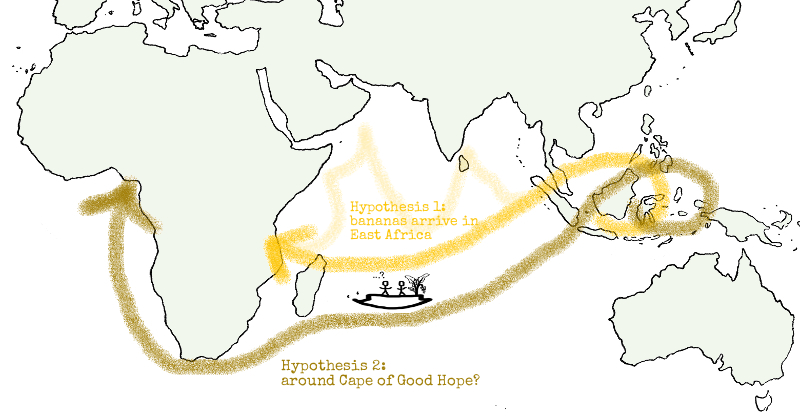
Now this might sound like science-fiction; R certainly did much eyebrow-arching and frowning when I told him about it. But it does highlight some puzzling facts that arise from what we currently know of bananas in Africa.
But first of all, I’ll have to explain a term that I’ve previously mentioned in a pretty cavalier fashion, because I couldn’t do a proper introduction. Now’s the time for that. I’m referring to the word plantain.
[I go off in a different lexical direction in Spanish… see here (external website!), if fluent in Spanish, and interested]
Plantains, as one may have noticed from Liz’s references to “banana plantains” in her recipes using matoke, are conceptually linked to cooking.
Plantains are cooking bananas… but not all cooking bananas are plantains—or botanically referred as such. However, it’s not like we have a botanically straightforward definition for what makes a plantain vs a banana. I’ve seen it used though most often with triploid cooking cultivars that have a specific genetic makeup: AAB.
(that would mean, in case you forgot, three sets of chromosomes: two sets from M. acuminata, and one from M. balbisiana).
From what I’ve gathered, there are mainly two branches of so-called plantains: African ones, and Pacific ones. Their genetic makeup, however, appears to be slightly different, which would imply slightly different origins for each group.
These African plantains were the bananas that were the Bantu stuff of conquest (if we accept their involvement in the Bantu expansion).
This in itself wouldn’t be a problem for the acceptance of a trans-Indian-Ocean arrival in East Africa for bananas and plantains, if it weren’t for one little detail:
there are no plantains in East Africa.
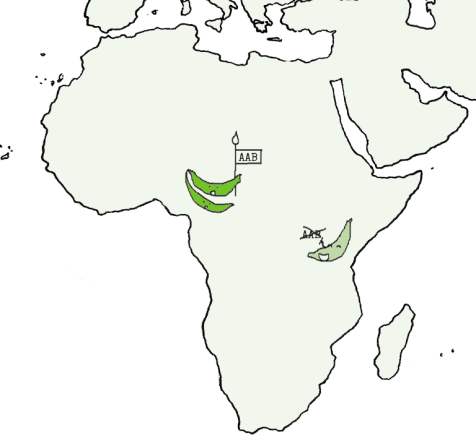
Well there are quite a few now, but their arrival is a lot more recent than what it ought to be, had they arrived such a long time ago on their shores.
So, does this mean that matoke isn’t, technically speaking, a plantain?
Just so. The different varieties commonly called matoke are, from what I’ve learnt, cooking bananas with a genetic makeup that differs from AAB African plantains; they are known as East Africa highland bananas, and they have no chromosome set from M. balbisiana: they are AAA (and you’ll see them referred to as AAA-EA).
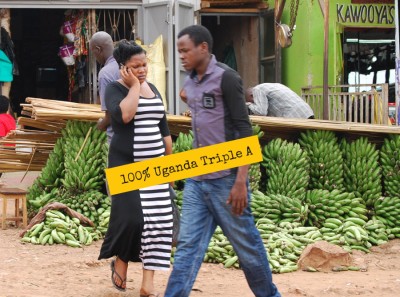
Besides, we have virtually no archaeobotanical finds in Africa that hint at how plantain and banana dispersal happened in the continent; the two main finds, one in Cameroon (Nkang, dated c. 800-400 BC) and the other one in Uganda (Munsa, 4th millennium BC), aren’t enough to tell a full story—and on top of that, the Uganda find appears to be quite polemical within the scientific community—.
(It’s also true that one would have to be pretty callous to expect Africans to grab a spade and begin digging in their spare time, in between ebola epidemics, ethnic conflicts and crop failures, just so we have more data to complete our bananistic knowledge database).
I am, though, rather puzzled at why nobody in Spain that I know of has thought of looking for Musa traces in medieval sites, so we needn’t rely exclusively on textual information to determine when, exactly, banana reached the Iberian peninsula, or to the Canary islands.
(If the reason is lack of funding, which is possible, I’ll just shut up).
From what I’ve been able to pierce together, medieval Andalusian texts mention banana trees, موز, which would’ve been cultivated along Granada’s coastal regions in the 10th century, together with sugarcane (a pretty old comrade-in-cultivation, as they both appear to have the same geographic origins: PNG-southeast Asia), as well as in Malaga and Cordoba. Humboldt mentions Fernández de Oviedo’s statement (who saw “musa” cultivated in Spain, “near the town of Armeria, in Grenada (sic)”), but I have no idea as to how long these plantings survived.
So, if anybody has information about studies finding Musa phytoliths* in those regions (being pretty distinctive, they might give lots of information concerning the arrival of this gigantic grass to our coasts), pray do let me know, ‘cause I’m vastly curious.
*Phytolith: microscopic silica bodies synthesized by living plant cells, which act as deterrents for hungry herbivores and, moreover, improve their structural support. So, they’re useful to plants. Yet the nice thing is they’re also useful to humans trying to study plant remains in excavation sites, because: a) their morphology varies depending on the plant we consider; b) they are easily preserved, and (relatively) easily retrieved from archaeological contexts; and this brings us to the logical conclusion, c) they are a diagnostic tool for detecting a plant’s use/consumption/presence, even when no other identifiable traces remain.
![]()
So, to wrap all this up and focusing once more on the African continent:
Genetically speaking, we can divide all triploid bananas that reached Africa in prehistoric times into two groups:
1 | Bananas commonly called “eastern highland bananas”, descendants of Musa acuminata, and thus having an AAA genetic makeup. These are cultivated in East and Central Africa, and are mostly used as cooking bananas, although several cultivars are used for brewing.
Matooke is the common name in Uganda for eastern highland cooking bananas (but not brewing ones; those appear to be called Mbidde types).
2 | Plantains, the African type, with AAB genetic makeup denoting the contribution of both M. acuminata and M. balbisiana to their birth. Their cultivation and use is most important in West and Central Africa.
We do not know when they arrived in Africa, exactly; it is hypothesized they arrived in two different waves, possibly following different routes, but the truth is we don’t know for sure.
Atop this banananistic, ‘ancestral’ substrate, later waves of banana-arrivals have crashed into Africa: other AAA* bananas (but not highland ones!), sweeter, to be eaten raw; as well as other triploid, ABB, cooking cultivars coming from Asia, more resistant to pests and drought conditions, among other things.
*Such as the AAA ‘Gros Michel’… “which is still grown in small quantities in East Africa as ‘Bagoya’”; Liz’s bogoya, perhaps?
African bananas/plantains are particularly interesting not only because of their mysterious past, but also because, as I mentioned earlier (… did I mention it before? If not, I should’ve), a whole third of world banana production is grown in Africa.
Uganda is, coincidentally, the world leader in cooking banana production, and this crop feeds over 80% of the population; production of highland cooking bananas is particularly relevant in the south-western regions, then exported mostly to the central area of the country (where the capital, Kampala, is).
So, although they might not be originally African, their huge impact on Africa’s history (gastronomic, agricultural, cultural) is undeniable.

Sources
So many, it’s rather challenging to organize them. The good news is that many of them are open access, so anybody interested can check them out for free in PDF.
A comprehensive, state of the art summary concerning banana science and history was recently (2011) published on PNAS:
Many of the articles that introduced me to the banananistic world of hybridizations, crosses, mysterious voyages and other adventures, can be freely consulted on the open access journal Ethnobotany Research and Applications, volume n. 7 (2009). There are a good thirteen articles about Musa, but the ones I specifically checked out for this article were the following:
- De Langhe et al. Why Bananas Matter: An introduction to the history of banana domestication.
- Perrier, X. Combining Biological Approaches to Shed Light on the Evolution of Edible Bananas.
- Neumann, K. y Hildebrand, E. Early Bananas in Africa: The state of the art , on the arrival of bananas in Africa, their historical and biological relevance, and the different hypotheses around the question.
- Blench, R. Bananas and Plantains in Africa: Re-interpreting the linguistic evidence, on the hypothesis suggesting a direct AAB-bananistic arrival to West Africa, along with a fascinating linguistic analysis on Musaceae & African languages.
More technical and genetically-oriented, yet also interesting, is Heslop-Harrison y Schwarzacher (2007), Domestication, Genomics and the Future for Banana, en los Annals of Botany 100:1073-1084.
On Musa phytolith discoveries in Africa, the main finds are described here:
- Lejju, B. J.; Robertshaw, P. and Taylor, D. 2006. Africa’s earliest bananas? Journal of Archaeological Science 33: 102-113 (for Ugandan find, dated late 4th mill BC)
- Mbida, C., W. van Neer, H. Doutrelepont & L. Vrydaghs. 2000. Evidence for banana cultivation and animal husbandry during the first millennium B.C. in the forest of southern Cameroon. Journal of Archaeological Science 27:151-162. (for Cameroon, dated first mill. BC; followups are summed up in the aforementioned article by Neumann and Hildebrand)
One of the first articles I read about crops and Africa, and their potential relevance for Bantu migrations, was the review by J. D. Farge (1961) Anthropology, Botany, and the History of Africa, in The Journal of African History 2 (2): 299-309.
Other, more recent articles talk about the Bantu expansion in connection with language and crops; one of the most accessible (and with better maps!) is the review by Diamond, J. And Bellwood, P. 2003. Farmers and Their Languages: The First Expansions. Science 300: 597-603.
On plantains, one can check several articles, although perhaps this webpage sums it all up pretty well: http://www.promusa.org/Plantain+subgroup
I did check more articles concerning plantains and East Africa Highland Bananas, a few of which are these:
- Ssebuliba et al. 2006. Reproductive efficiency and breeding potential of East African highland (Musa AAA-EA) bananas. Field Crops Research 95: 250–255.
- De Langhe, D.; Pillay, M.; Tenkouano, A. and Swennen, R. 2005. Integrating morphological and molecular taxonomy in Musa: the African plantains (Musa spp. AAB group). Pl. Syst. Evol. 255: 225–236.
However, I wouldn’t advise you check ’em out unless you’re *very* interested. Banana genetic & breeding minutiae alert.
In 2008 an international conference on Bananas in Africa took place; they were so awesomely thoughtful, they uploaded all their materials online and can be checked out via their main portal.
The main document is Moorhead, A. (ed). (2012). A strategy for banana research and development in Africa: a synthesis of results form the conference banana2008, held 5-9 October 2008, Mombasa, Kenya. ISHS
For those of you that are *very* interested in bananas, and what’s currently going on with this plant, I’d recommend you head straight to the Banana and Plantain Section of Biodiversity International; from there, you may access the Musalit database, an absolute must where all kinds of Musa-related publications are indexed (and, often, also freely accessible!), contributed by researchers working in the field.
Another excellent source of information are the publications of Infomusa, curated by the same professionals involved in Musalit&other bananophyle platforms; many of these are freely accessible on internet.
The last bananistic resource I’m sharing today is also the source of some of the maps included in the article: the Crop Mapper Spatial information on global banana production systems. It aims to gather in one centralized database all spatial information on world banana production, and make it freely accessible. Despite my annoyance with their search capabilities (more like, INcapabilities… doesn’t work for me!), it’s a lovely resource, and I sure spend quite some time playing around with it.
Illustrations
Comically bad maps, by Yours Truly; map where subspecies are charted, cropped from a screenshot of Crop Mapper (see above). Map with arrow pointing at Bantu expansion direction, well, duh… saw the Google logo down there? Well it’s there for a reason.
Pictures, again, by me, myself, and R (sweet banana vs matooke).
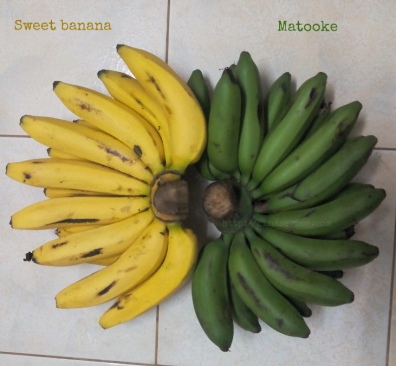


One thought on “Musa-ings on the Mato(o)ke Mysteries (2): The Forest”